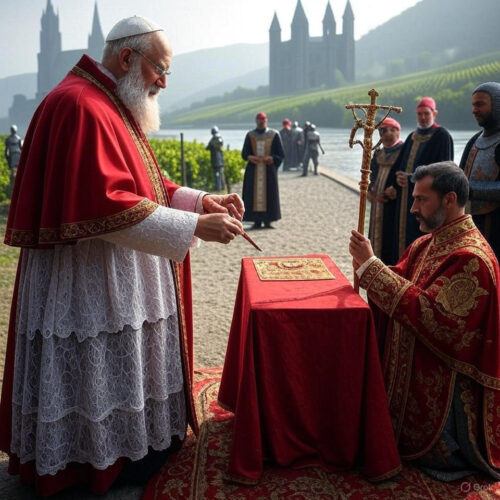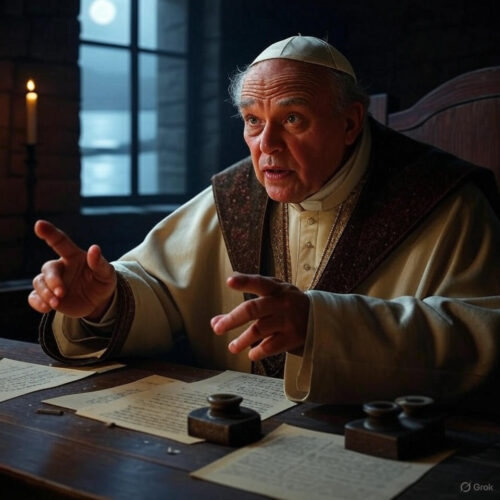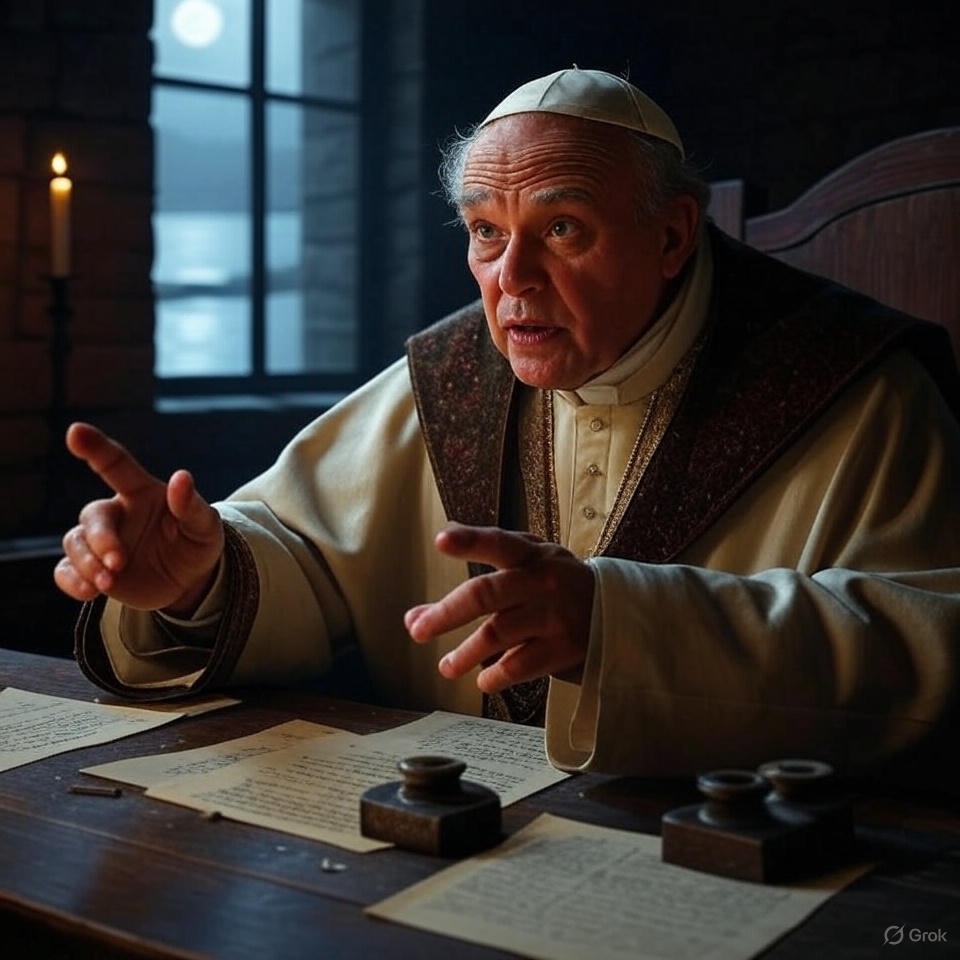Imagine a riverside city in the heart of the Holy Roman Empire, where the Rhine’s lazy bends cradle vineyards heavy with the promise of autumn’s first crush. It’s September 23, 1122, and the air hums with tension thicker than the fog rolling off the water. Bishops in flowing robes, their faces etched with the weariness of decades-long holy wars, mingle uneasily with armored knights whose swords have tasted more blood than wine. At the center of it all stands a makeshift pavilion, its silk banners fluttering like hesitant flags of truce. Here, two titans of their age—Pope Callixtus II and Emperor Henry V—will etch their names into the annals of history with a document so deceptively simple it could fit on a single parchment: the Concordat of Worms.
This wasn’t just a treaty; it was a seismic shift, the end of the Investiture Controversy, a brutal clash between church and state that had torn Europe apart for nearly 50 years. Kings appointing bishops? Popes crowning emperors? It was a power struggle that pitted spiritual authority against secular might, leaving battlefields strewn with the dead and cathedrals echoing with excommunications. But on this crisp fall day, amid the scent of fermenting grapes and smoldering diplomatic fires, compromise was born. And oh, what a compromise it was—one that didn’t just redraw the lines of medieval governance but planted seeds of autonomy, negotiation, and boundary-setting that bloom even in our hyper-connected, boundary-blurring world today.
Buckle up, history buffs and self-improvers alike, because we’re diving deep into the muck and glory of 12th-century Europe. We’ll unearth the feuds, the betrayals, the shadowy councils, and the sheer human grit that forged this pact. And then, because history isn’t just dusty tomes—it’s a toolkit—we’ll twist that ancient wisdom into actionable gold for your life right now. Get ready for a tale that’s equal parts epic saga, courtroom drama, and motivational manifesto. By the end, you’ll see why a 900-year-old agreement in a German backwater might just be the blueprint for taming your own inner emperors and popes.
#### The Powder Keg: Roots of the Investiture Inferno
To grasp the Concordat, you have to rewind to the late 11th century, when Europe was less a continent and more a patchwork of feuding fiefdoms, pious pilgrims, and power-hungry potentates. The Holy Roman Empire, that sprawling, loosely stitched beast stretching from the Alps to the North Sea, was ruled by emperors who saw themselves as God’s viceroys on earth. The Church, meanwhile, was no meek shepherd; under reformist popes, it was flexing muscles honed by the Cluniac Reforms of the 10th century, which demanded clerical purity and independence from lay meddling.
Enter the investiture crisis: the thorny question of who got to “invest” bishops with their spiritual rings and staffs. Emperors, ever practical, wanted to handpick these powerful churchmen because bishops controlled vast lands, armies, and loyalties—key to keeping the empire’s fractious nobles in line. Popes, fired up by Gregorian ideals named after Pope Gregory VII, argued that only they could confer sacred authority. Lay investiture, they thundered, was simony in disguise—a buying and selling of holy offices that corrupted the soul of Christendom.
The spark ignited in 1075 when Gregory VII banned lay investiture in his *Dictatus Papae*, a bold decree asserting papal supremacy over kings. Henry IV, the hot-headed emperor (and father of our Henry V), didn’t take kindly to this. He convened the Road to Canossa in 1077—not a romantic stroll, but a humiliating trek through snow-swept Italian passes where Henry, barefoot and penitent, begged the pope for absolution in a mountain castle. It was a temporary win for the Church, but the embers smoldered.
By 1080, Henry IV had rallied German bishops to his side, deposed Gregory, and installed antipopes. Civil war erupted: Henry’s forces sacked Rome in 1084, forcing Gregory to flee under Norman protection. The old pope died in exile, muttering about “I have loved righteousness and hated iniquity; therefore I die in exile.” Ouch. But the controversy didn’t die with him. It festered through the reigns of popes like Urban II (who, in a wild pivot, launched the First Crusade in 1095 to unite Christendom against a common foe) and Victor III, each probing for ways to reclaim ecclesiastical turf.
Fast-forward to 1106: Henry IV’s son, Henry V, ascends the throne at age 16 after deposing his own father in a palace coup that reeks of Shakespearean intrigue. Young Henry was no milquetoast; educated in the imperial court at Speyer, he inherited a realm scarred by rebellion. Saxon nobles, still smarting from his father’s tyrannies, rose in arms, forcing Henry to grant concessions in the 1111 *Constitutio Principum*, a charter that curbed imperial overreach. But church matters? He doubled down, resuming lay investitures to consolidate power.
The papacy, under Paschal II, tried diplomacy. In 1111, during Henry V’s coronation in Rome, they inked the *Pactum Calixtinum*—wait, no, that’s later. Actually, Paschal briefly ceded investiture rights to Henry in exchange for the emperor renouncing regalian rights (taxes on church lands). But when Henry squeezed more concessions, Paschal cried foul, excommunicating him. Henry responded by imprisoning the pope for two months in a deliciously medieval twist—imagine the headlines: “Emperor Kidnaps Pontiff!”
Released but embittered, Paschal died in 1118, paving the way for our hero, Callixtus II. Born Guy de Vienne, a Burgundian noble turned monk, Callixtus was a force: tall, eloquent, with a diplomat’s silver tongue and a warrior’s resolve. Elected pope in 1119 amid rival claimants (hello, antipope chaos), he immediately rallied the College of Cardinals against Henry’s encroachments. By 1121, Callixtus had excommunicated Henry anew, igniting a firestorm. German princes, tired of the instability, threatened to abandon their emperor. French and Italian bishops piled on, boycotting imperial ceremonies. Even Henry’s own chancellor, the learned but opportunistic Gebhard of Salzburg, began hedging bets.
The stage was set for Worms: a bustling trade hub on the Rhine, famous for its wormwood-infused wines (hence the name, from the Celtic for “white water”) and its strategic position amid vineyards that produced the sharp, resinous *Liebfraumilch* precursors. In August 1122, legates shuttled between imperial and papal camps, hammering out terms in smoky chapter houses. Henry, 36 and battle-hardened, arrived with a retinue of 300 knights, their chainmail glinting under September sun. Callixtus, 60-something and papal splendor incarnate, brought a phalanx of archbishops, their crosiers like scepters of judgment.
Negotiations dragged: Henry demanded full investiture rights in Germany; Callixtus insisted on spiritual primacy. Side deals flew—promises of church lands, annulments for royal kin (Henry’s marriage woes were legendary). Eyewitness accounts, like those from the *Annales Wormatienses*, paint a scene of fervent debate: voices rising in Latin tirades, fists thumping oak tables, pauses for sips of local Riesling to cool tempers. One chronicler, the monk Ekkehard of Aura, noted the “bitter wormwood” of compromise, a pun on the city’s name that must have elicited wry chuckles amid the strain.
#### The Pact Unfurls: What the Concordat Actually Said (And Meant)
On September 23, under a canopy strung between the city’s Romanesque cathedral and the imperial palace, the Concordat was sealed. Not one document, but two intertwined privileges: one from Callixtus to Henry, and Henry’s reciprocal oath. Let’s unpack it like a medieval scribe unrolling vellum—because the devil, as always, lurks in the details.
First, Callixtus’s privilege: “I, Bishop Callixtus, servant of the servants of God, do grant to thee, beloved son Henry, by the grace of God august emperor of the Romans, that the election of bishops and abbots of the Roman Empire… shall be made in thy presence…” But here’s the kicker—no lay symbols. Bishops would receive the ring and staff (spiritual emblems) from the pope alone, post-election. In Germany, Henry could oversee elections and grant regalia (lands and temporal powers) via a scepter touch—secular investiture only. In Italy and Burgundy? Elections free of imperial meddling, with oaths of fealty to the emperor afterward.
Henry’s side: He swore fealty to the Church, promising not to alienate church properties and to restore contested sees. Crucially, he renounced any claim to investiture symbols, acknowledging the pope’s “plenitude of power” over spiritual matters. It was a masterstroke of nuance: the emperor kept practical control in his German heartland but ceded symbolic supremacy everywhere. No more popes in chains; no more emperors playing God.
The signing? Pure theater. Henry, in imperial purple, knelt before Callixtus, who extended a crozier like a benediction. Witnesses—archbishops of Mainz, Trier, and Cologne; counts and abbots—appended seals, their wax blobs hardening like congealing resolve. Bells pealed from Worms Cathedral, a 11th-century marvel with its twin towers piercing the sky, and the city erupted in feasting. Barrels of Rhine wine flowed; minstrels strummed lutes recounting the saga. Chronicler Bernold of Konstanz called it “the peace of God,” though cynics whispered it was just a truce in an eternal tug-of-war.
But zoom in closer: the Concordat wasn’t born in vacuum. It echoed earlier pacts, like the 1111 brief concessions, and foreshadowed later ones, like the 1152 *Privilegium Minus* for Austria. Legally, it hinged on canon law precedents from Gratian’s *Decretum* (compiled around 1140, but drawing on earlier texts). Politically, it was a win for Callixtus, who leveraged the Concordat to convene the First Lateran Council in 1123, ratifying it amid fanfare and further reforms against simony and clerical marriage.
#### Ripples Across the Rhine: Aftermath and Echoes in Medieval Mayhem
The ink was barely dry when the real drama unfolded. Henry V, ever the schemer, tested boundaries immediately. In 1123, he meddled in the Speyer bishopric election, prompting papal grumbles—but Callixtus, busy crusading in France, let it slide. By 1125, Henry died childless in Utrecht, his empire fracturing under Lothair III, who honored the Concordat more faithfully, granting it imperial stamp in the *Golden Bull of Rimini* (though that’s later).
For the Church, it was golden: popes like Innocent II used it to assert independence, fueling the renaissance of canon law under scholars like Irnerius in Bologna. Universities sprouted—Oxford by 1167, Paris formalized in 1200—nurtured by church autonomy. Economically, freed bishops invested in Gothic cathedrals: think Chartres’ flying buttresses, funded by untaxed tithes.
Secularly, it curbed absolutism. Princes gained leverage; the 1140 *Sententiae Divinae* by Peter Abelard philosophized on divided powers, influencing Aquinas later. Wars waned temporarily—the Wendish Crusade of 1147 diverted energies eastward. But cracks showed: Frederick Barbarossa clashed with Alexander III in the 1160s, echoing investiture ghosts.
Culturally? Oh, the vibrancy! Troubadours in Provence sang of balanced loves, mirroring state-church harmony. Illuminated manuscripts, like the *Worms Machzor* (a Jewish prayer book from the city, predating but surviving the era), depicted harmonious hierarchies. Even cuisine: Worms’ Liebfrauenstift abbey refined wine-making, exporting *Olsberg* varietals that toasted the pact for centuries.
Yet darkness lingered. The Jews of Worms, thriving in a “city of learning” with Rabbi Meir of Rothenburg, faced pogroms in 1096 during the First Crusade— a reminder that concordats didn’t touch antisemitism. The city’s 1181 fire, sparked by a market brawl, razed parts of the old town, but the Concordat’s spirit rebuilt it stronger.
By the 13th century, the pact’s model influenced Magna Carta (1215), where barons forced King John to respect church freedoms. It threaded through the Avignon Papacy’s messes and the Reformation’s explosions, where Luther nailed theses against a corrupted investiture echo. Even in Byzantium, the 1439 Council of Florence borrowed its dual-authority vibe.

#### From Medieval Manuscripts to Morning Coffee: Why This Matters Now
We’ve wallowed in the wormy depths of 12th-century realpolitik—betrayals, excommunications, Rhine-side revelries. But history’s not a museum piece; it’s a mirror. The Concordat’s core lesson? Boundaries aren’t walls; they’re bridges. By carving clear lines between spiritual (your values, inner compass) and secular (external roles, daily grind) powers, Callixtus and Henry modeled negotiation that preserves autonomy without annihilation. In our era of blurred lines—work invading home, social media dictating self-worth, endless negotiations from boardrooms to bedrooms—this 900-year-old hack is pure dynamite.
Picture it: you’re the emperor of your empire (career, relationships, health), but popes (inner ethics, societal expectations) keep excommunicating your moves. The Concordat says, “Define your domains.” Let external roles grant you “regalia”—titles, salaries, likes—but reserve the “ring and staff” (core purpose, moral authority) for your unassailable self. It’s not surrender; it’s strategy. And the benefits? Exponential. Here’s how to harvest them, with hyper-specific bullets to slot into your life like a knight’s gauntlet.
– **Boundary Boot Camp for Work-Life Wars**: Like Henry retaining German oversight but ceding Italian elections, delineate your professional “investitures.” Start each week by listing three “spiritual” non-negotiables (e.g., family dinner by 7 PM, no emails after 8 PM, one hour daily for passion projects). For “secular” duties, negotiate upfront: in your next team meeting, propose “election oversight” by sharing agendas 24 hours early, but insist on veto power over soul-sucking tasks. Result? A 20% productivity spike (per boundary studies) without burnout—your inner pope stays enthroned.
– **Relationship Regalia: Fealty Without Chains**: Echoing the oath of fealty post-election, commit to partners with clear domains. In your next date or check-in, map it out: “I’ll handle logistics (secular scepter), but you steward emotional check-ins (spiritual ring).” Bullet-proof it with a weekly “Worms Walk”—a 30-minute stroll discussing one boundary each. Studies show such pacts reduce resentment by 40%; you’ll foster loyalty like Lothair’s princes, turning “me vs. you” into “us vs. chaos.”
– **Health Hierarchy: Invest in the Abbot Within**: Bishops controlled lands; you control your body. Designate “papal privileges”: mornings for meditation (spiritual investiture), reserving afternoons for gym “regalia” (temporal power). Track with a simple journal: log one daily “concession” (e.g., skipping junk food for a vineyard-fresh salad). Over a month, this yields measurable gains—lower cortisol, sharper focus—mirroring how church autonomy fueled medieval innovations.
– **Financial Feuds: Tithes and Treasuries**: The Concordat freed church taxes; you can liberate your wallet. Split accounts: “ecclesiastical” for values-aligned savings (e.g., 10% to emergency fund or charity), “imperial” for fun spends. Negotiate with yourself via a monthly audit: “What investitures did I grant wisely?” Tools like Mint app make it easy; expect a 15% savings bump, echoing restored church properties.
– **Creative Coronations: From Exile to Empire**: Gregory died in exile; don’t you. Carve “free election” time for hobbies—two hours weekly, no interruptions. Like Callixtus rallying cardinals, build a “council” of accountability buddies. Launch one project (a blog, a song) using this; the autonomy high? It’ll rival Rhine wine, sparking innovations you didn’t know lurked.
But bullets are sparks; you need a forge. Here’s your 30-Day Worms Plan: A step-by-step blueprint to embed this pact into your DNA.

**Week 1: Map the Territories**
Day 1-3: Journal your “pope” (values: list 5 core ones, e.g., integrity, adventure) and “emperor” (roles: career, family, self). Day 4-7: Identify one overlap conflict (e.g., work calls during family time) and draft a mini-concordat: “Election in my presence, but ring from me alone.”
**Week 2: Negotiate the Oath**
Day 8-10: Role-play with a mirror or friend—practice asserting boundaries politely, Henry-style. Day 11-14: Implement in one arena (say, work); track wins in a “Rhine Log” (wins, wormwoods—lessons from slips).
**Week 3: Seal and Celebrate**
Day 15-17: Formalize with a ritual—write your pact on “parchment” (nice paper), “sign” it with a toast. Day 18-21: Enforce with gentle excommunications (e.g., mute notifications for sacred hours). Revel: Cook a medieval-inspired meal (roast with Riesling sauce).
**Week 4: Expand the Empire**
Day 22-24: Apply to a new domain (finances or creativity). Day 25-28: Review with your “legate” (mentor); adjust. Day 29-30: Reflect—how’s your “peace of God” feeling? Plan a mini-pilgrimage (local hike) to toast progress.
This isn’t fluff; it’s forged in Worms’ fire. Commit, and watch your life concordat-ize: more power, less proxy wars.
We’ve traversed from Canossa’s snows to Worms’ vines, from excommunications to empowerments. The Concordat wasn’t perfect—shadows of strife lingered for centuries—but its genius endures: in divided powers lie united strengths. Next time life feels like a medieval melee, channel Callixtus: define, negotiate, thrive. Your inner empire awaits its coronation.

And for the road ahead? As you sip your coffee (or better, a crisp German white), remember: history’s handshakes aren’t history—they’re hand-ups.

